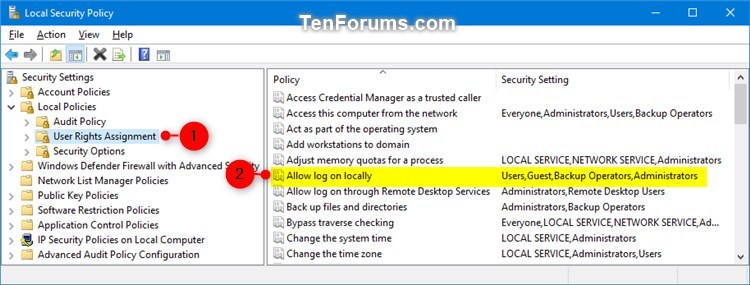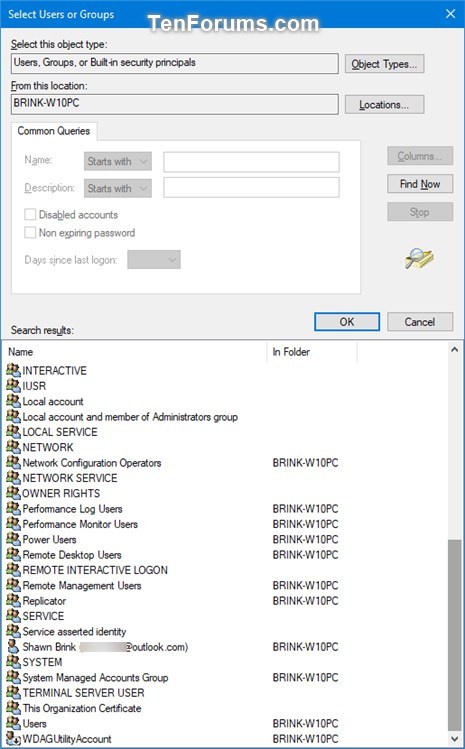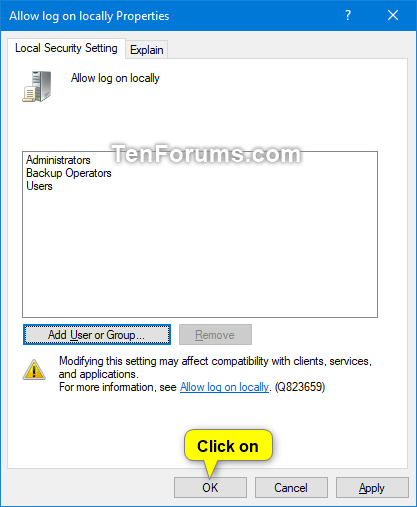How to Allow or Prevent Users and Groups to Sign in Locally to Windows 10
By default, you need to dismiss the lock screen and enter your credentials to sign in to Windows 10 with your account.
By default, Users, Guests, Backup Operators, and Administrators are able to sign in locally to Windows 10.
See also: Allow log on locally - security policy setting (Windows 10) | Microsoft Docs
This tutorial will show you how to allow or prevent specific users and groups from being able to sign in (log on) locally to a Windows 10 PC.
You must be signed in as an administrator to allow or prevent users and groups to sign in locally.
Only allowed users and groups will be able to sign in locally to Windows 10. The Deny log on locally policy will override this Allow log on locally policy.
- Option One: Allow Users and Groups to Sign in Locally in Local Security Policy
- Option Two: Prevent Users and Groups to Sign in Locally in Local Security Policy
- Option Three: Allow or Prevent Users and Groups to Sign in Locally in Command Prompt
EXAMPLE: "The sign in method you're trying to use isn't allowed. For more info, contact your network administrator." message when a user or group is not allowed to sign in locally
Local Security Policy is only available in the Windows 10 Pro, Enterprise, and Education editions.
All editions can use Option Three below.
1. Press the Win+R keys to open Run, type secpol.msc into Run, and click/tap on OK to open Local Security Policy.
2. Expand open Local Policies in the left pane of Local Security Policy, click/tap on User Rights Assignment, and double click/tap on the Allow log on locally policy in the right pane. (see screenshot below)
3. Click/tap on the Add User or Group button. (see screenshot below)
4. Click/tap on the Advanced button. (see screenshot below)
5. Click/tap on the Object Types button. (see screenshot below)
6. Check all the boxes for Object types, and click/tap on the OK. (see screenshot below)
7. Click/tap on the Find Now button, select the name of the user or group (ex: "Guests") you want to add, and click/tap on OK. (see screenshots below)
If you like, you can press and hold the Ctrl key to select more than one user and/or group.

8. Click/tap on OK. (see screenshot below)
9. Click/tap on OK. (see screenshot below)
10. When finished, you can close Local Users and Groups if you like.
Local Security Policy is only available in the Windows 10 Pro, Enterprise, and Education editions.
All editions can use Option Three below.
1. Press the Win+R keys to open Run, type secpol.msc into Run, and click/tap on OK to open Local Security Policy.
2. Expand open Local Policies in the left pane of Local Security Policy, click/tap on User Rights Assignment, and double click/tap on the Allow log on locally policy in the right pane. (see screenshot below)
3. Select the user or group (ex: "Guest") you want to remove, and click/tap on the Remove button. (see screenshot below)
If you like, you can press and hold the Ctrl key to select more than one user and/or group.
4. Click/tap on OK. (see screenshot below)
5. When finished, you can close Local Users and Groups if you like.
1. If you haven't already, you will need to do the following below before continuing on to step 2 below.
A) Download the ntrights.exe file below from the Windows Server 2003 Resource Kit Tools.
B) Save the ntrights.zip file to your desktop, and unblock it.
C) Open the ntrights.zip file, copy or move the ntrights.exe file into your C:\Windows\System32 folder, and click/tap on Continue to approve.
2. Open an elevated command prompt.
3. Type the command you want below into the elevated command prompt, and press Enter.
(Add user or group to allow)

ntrights +r SeInteractiveLogonRight -u "User or Group"
OR
(Remove user or group to prevent)

ntrights -r SeInteractiveLogonRight -u "User or Group"
Substitute User or Group in the command above with the actual name of the user or group (ex: "Guests) you want to add or remove for this policy.
For example:ntrights +r SeInteractiveLogonRight -u "Guests"
4. When finished, you can close the elevated command prompt if you like.
That's it,
Shawn
Related Tutorials
- How to Add or Remove Users from Groups in Windows 10
- How to Change User Rights Assignment Security Policy Settings in Windows 10
- How to Deny Users and Groups to Sign in Locally to Windows 10
- How to Enable or Disable User Accounts in Windows 10
- How to Sign in to Windows 10
- How to Enable or Disable Show Local Users on Sign-in Screen on Domain Joined Windows 10 PC
- How to Hide or Show Your Email Address on Sign-in Screen in Windows 10
- How to Do Not Display Last Signed-in User Name on Sign-in Screen in Windows 10
- How to Enable or Disable Don't Display Username at Sign-in in Windows 10
- Enable or Disable Display Last Sign-in Information during User Sign-in in Windows 10
- How to Add a Message at Sign-in for Users in Windows 10
- How to Allow or Prevent Users and Groups to Log on with Remote Desktop in Windows 10
- How to Deny Users and Groups to Log on with Remote Desktop in Windows 10
Allow or Prevent Users and Groups to Sign in Locally to Windows 10

Allow or Prevent Users and Groups to Sign in Locally to Windows 10
How to Allow or Prevent Users and Groups to Sign in Locally to Windows 10Published by Shawn BrinkCategory: User Accounts
30 Mar 2019
Tutorial Categories


Related Discussions













